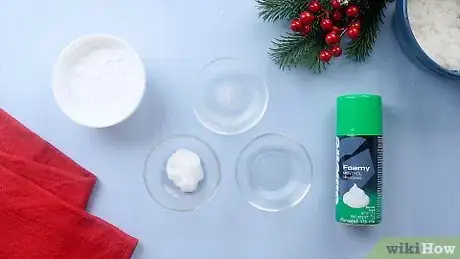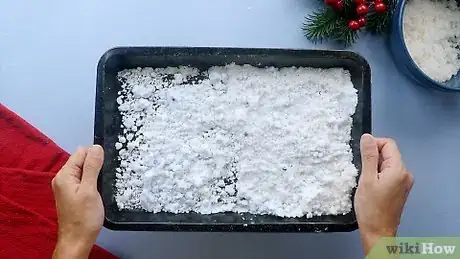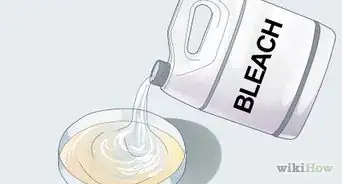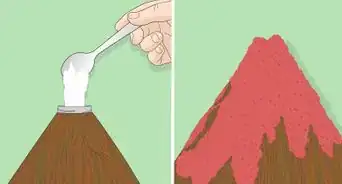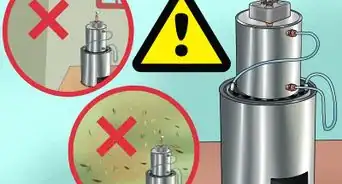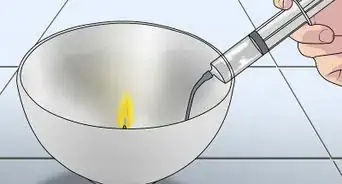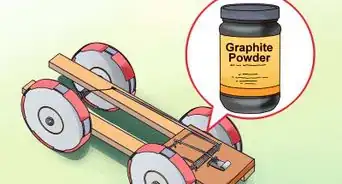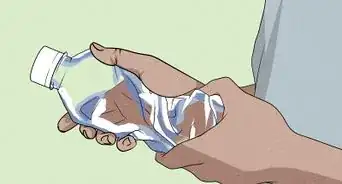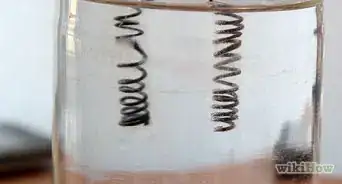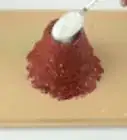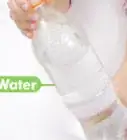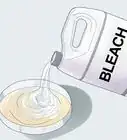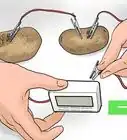This article was co-authored by Meredith Juncker, PhD. Meredith Juncker is a PhD candidate in Biochemistry and Molecular Biology at Louisiana State University Health Sciences Center. Her studies are focused on proteins and neurodegenerative diseases.
This article has been viewed 81,936 times.
Did your family miss out on a white Christmas this year? Are you having an unseasonably warm winter? Or do you live in the tropics and covet the chance to play in snow? This can be easily remedied by making fake snow with baking soda! There are a number of common household items you can use as your wet ingredient, so just use whatever’s handy or make a test batch of each recipe to find your favorite. Then entertain the kids with a fun science project that can be used in a variety of ways.
Steps
Choosing Recipes
-
1Experiment with different recipes. Baking soda snow is made from common household ingredients. Chances are that you can whip some up using each recipe without having to run to the store. So create a small test batch of each if you’re so inclined. Find out which is most pleasing to the eye, touch, or both before buying in bulk.
- Even if you decide to go with only one recipe right away, start with a small batch. Snow comes in all sorts of consistencies, from dry and powdery to wet and mushy, so there’s no precise measurements that you need to follow. Start small so you can figure out the ratio of baking soda to other ingredients that works best for you personally.
-
2Combine baking soda with shaving foam. Add 1 cup (221 g) of baking soda to a mixing bowl or similar container. Then spray shaving foam from a can into the bowl. Start with just a little squirt, then knead the 2 ingredients together. Keep adding additional squirts of shaving foam until your snow reaches your desired texture.[1]Advertisement
-
3Mix conditioner with baking soda. Add 1 cup (221 g) of baking soda to a mixing bowl or similar container. Then add 1 tablespoon (15 ml) of white hair conditioner. Stir or knead to combine the ingredients. Continue to add 1 tablespoon (15 ml) of conditioner at a time, until the mixture forms the consistency that you’re aiming for.[2]
-
4Use plain old water with baking soda. Start with 1 cup (221 g) of baking soda in a mixing bowl and then pour 1 tablespoon (15 ml) of water into it. Stir it in with a fork, then add 1 tablespoon (15 ml) of water and stir again. Continue in this fashion until the snow reaches a consistency that you like.[3]
-
5Jazz your snow up. Whatever recipe you follow, consider giving it some extra flair. Stir in some silver, blue, or purple glitter (or a combination) to make your snow sparkle. Add a few drops of scented essential oils to fill the air with pleasant smells.[4]
Using Your Snow for Fun-Filled Activities
-
1Let everyone make their own. Half the fun of baking soda snow is getting your hands “dirty.” If this is a group activity for kids, let each make their own batch. Give the kids the thrill of making a mess with ingredients that are actually cleaners.[5]
- At the same time, keep a close eye on young children who have a habit of putting things in their mouths. Instruct all young children not to consume it.
-
2Decorate mason jar snow globes. With each jar, rub a glue stick (or white school glue from a bottle) over the inside of the jar’s lid. Press the bottom of whatever elements you’re adding (like a Santa, sleigh, or an evergreen figurine) into the glue until it’s firmly in place. Then dust the rest of the lid with your fake snow and screw the jar on upside-down.[6]
-
3Make snowmen and other shapes. Be sure to add enough liquid ingredient to your batch so that your snow is easily molded without crumbling. Then simply ball some up to form a snowman as you would with real snow. Or, break out the sand toys from your last beach trip to make snow castles instead of sand castles.[7]
-
4Form a landscape for playtime. Make enough snow to cover a wide area like a tabletop. Then invite the kids to break out their favorite action figures and dolls for a wintry blast. Let the Barbies go skiing, reenact the Battle of Hoth with Star Wars figures, or do whatever else their imagination comes up with.[8]
-
5Make your snow fizz. Adding vinegar to baking soda causes a perfectly safe chemical reaction that makes the baking soda erupt into fizz, much like the Mentos-and-soda trick. Amuse the kids by giving them a bowl of vinegar to drop their snowballs into. For some twisted Bond-villain fun, make snowmen, inject them with a dropper filled with vinegar, and cackle evilly as they melt from the inside out.[9]
Keeping Safe and Clean
-
1Supervise the kids. The older they are, the less of a concern this is. However, with young kids, stick around and oversee their science project and playtime in case they’re tempted to make snowballs. This might seem to them like an obvious way to have fun with fake snow, but keep in mind that baking soda is pretty abrasive in large amounts and not something you want to get in your eye. It’s not the end of the world if it does, but stinging eyes might be the end of fun time.[10]
- Baking soda snow isn’t advisable for very young kids who still have a habit of putting things in their mouths, especially if you’re using shaving cream or hair conditioner as a wet ingredient.
-
2Lay a protective surface out for easy clean-up. Cover the table, floor, or wherever you’re making fake snow with a bedsheet, towel, or similar material. Once playtime is over, simply bundle it up by its corners, shake it over the bathtub, and rinse the fake snow down the drain. Then vacuum the floor where any of it may have spilled off the sheet.[11]
- With the exception of shaving foam, all of them are commonly used as cleaners, so there’s really no stress if a big mess was made.
-
3Take it outdoors. To make clean-up even less of a concern, take your project outside as long as the weather is clear. Avoid doing so on wet or windy days, since moisture and strong winds will dissolve and scatter your snow. Otherwise, do the same activities as you would inside, or even decorate bushes, patio furniture, or other outside fixtures with freshly fallen snow.
Community Q&A
-
QuestionHow long does the fake snow last?
 Community AnswerFake snow last for 7 - 10 days if left uncovered and spread out thinly. This also varies depending on the humidity of area.
Community AnswerFake snow last for 7 - 10 days if left uncovered and spread out thinly. This also varies depending on the humidity of area. -
QuestionCan this be added into slime?
 Community AnswerYes, if you add snow into the slime it will make cloud slime. Cloud slime has a very stringy texture and is fluffy and soft; it kind of feels like kinectic sand.
Community AnswerYes, if you add snow into the slime it will make cloud slime. Cloud slime has a very stringy texture and is fluffy and soft; it kind of feels like kinectic sand. -
QuestionIf I use baking soda snow in cloud slime, will it work as well as store bought instant snow?
 Community AnswerNo, baking soda will over-activate the slime, making it harder and not as stretchy.
Community AnswerNo, baking soda will over-activate the slime, making it harder and not as stretchy.
Things You’ll Need
- Mixing bowl(s) or similar containers
- Measuring cups and spoons
- Spoon or fork for stirring
- Bedsheet, towel, or other protective covering
- Baking soda
- Shaving foam, hair conditioner, or water
References
- ↑ http://www.kidsplayandcreate.com/pretend-fake-snow-recipes-for-kids-how-to-make-snow-paint-snow-clay-for-kids/
- ↑ http://www.kidsplayandcreate.com/pretend-fake-snow-recipes-for-kids-how-to-make-snow-paint-snow-clay-for-kids/
- ↑ http://pureella.com/how-to-make-artificial-snow-3-quick-easy-eco-friendly-recipes/
- ↑ http://www.raisinglifelonglearners.com/snow-dough-science/
- ↑ http://playtivities.com/how-to-make-snow/
- ↑ http://pureella.com/how-to-make-artificial-snow-3-quick-easy-eco-friendly-recipes/
- ↑ http://playtivities.com/how-to-make-snow/
- ↑ http://www.raisinglifelonglearners.com/snow-dough-science/
- ↑ http://www.raisinglifelonglearners.com/snow-dough-science/
